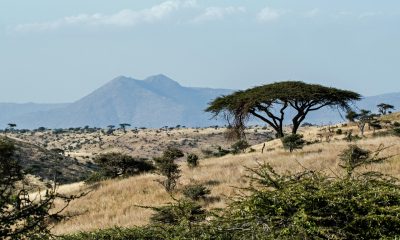Africa
New drug to treat HIV/AIDS introduced in South Africa
Introduction of the three-in-one pill is expected to treat the 7.7 million South Africans who have HIV. Zweli Mkhize, South Africa’s health minister, described it as “the fastest way to reduce HIV viral load.” One of the main ingredients, dolutegravir, is already the drug of choice in higher-income countries. The cheaper regimen could allow up to 5 million more people to receive treatment.

South Africa is at the forefront of the fight against HIV with the introduction of a new treatment consisting of a three-in-one tablet that is considered more cost effective.
Keep up to date with the latest business headlines and sharp analysis from around the world. Current news by industry verticals: finance, biotech, cannabis, and much more.
South Africa, the country most affected by HIV/AIDS in the world, is about to launch a new treatment that is presented as more cost-effective than anything currently available. This treatment, the TLD, which was launched on December 1 on World AIDS Day, is considered by the South African authorities to be “the fastest way to reduce viral load.”
It should be noted that there are 7.7 million people living with HIV in South Africa, 4.8 million of whom are receiving antiretroviral treatment. The highest prevalence rate is found among adults aged 15 to 49 years. According to Unitaid, 10% of AIDS deaths and 15% of new HIV infections worldwide occur in this country.
What is the new HIV/AIDS treatment?
The new HIV/AIDS treatment was presented on November 27, by South African Health Minister Zweli Mkhize in Kwazulu-Natal, South Africa’s province most affected by HIV. The TLD combines three antiretroviral drugs, tenofovir disoproxil, lamivudine and dolutegravir in a single tablet. “It is a highly effective treatment” allowing “much faster virus removal” than others and it causes “fewer side effects,” Robert Matiru, Unitaid’s director of operations, told AFP.
Described by South African Health Minister Zweli Mkhize as “the fastest way to reduce HIV viral load”, fixed-dose combination has fewer side effects and is easier to take than other forms. Dolutegravir, one of the main ingredients, is already the drug of choice in high-income countries.
How much does the new treatment cost?
The treatment is financially supported by Unitaid, an international global health organization. This affordable treatment – $75 per person per year – should enable some 5 million more infected people in South Africa to begin and, above all, to continue to receive treatment.
On November 26, UNAIDS highlighted the increase in the number of HIV-positive people receiving treatment and recognized the key role of affected communities in the fight against AIDS. 24.5 million people living with HIV were receiving HIV treatment by mid-2019, about two-thirds of the world’s HIV-infected population, according to UNAIDS. This represents an increase of 1.2 million in the number of people treated in six months, but more needs to be done to reach the target of 30 million by the end of 2020.
In a report released before World AIDS Day on December 1, UNAIDS highlighted the critical need to help community-based organizations expand access to antiretroviral therapy, promote compliance with treatment and reach those most affected by HIV. According to the report “Power to the People”, there were 1.7 million new infections worldwide in 2018. “I wouldn’t be alive today, physically or emotionally, without my community” and its “support,” said Laurel Sprague, HIV carrier and Unaids community mobilization counselor, at a press conference.
South Africa, a country that actively fights against HIV/AIDS
A dozen countries have reduced the number of new adult HIV infections by at least 26% since 2010, including South Africa (39%), the Democratic Republic of the Congo (37%), Uganda (36%) and Zimbabwe (28%). However, in Nigeria, new adult HIV infections increased by 8% compared to 2010, while in Pakistan new adult HIV infections increased by 56%. HIV-related deaths in 2018 fell to about 770,000, a third less than in 2010. 37.9 million people are currently living with HIV worldwide, UNAIDS estimated.
__
(Featured image by Hal Gatewood via Unsplash)
DISCLAIMER: This article was written by a third party contributor and does not reflect the opinion of Born2Invest, its management, staff or its associates. Please review our disclaimer for more information.
This article may include forward-looking statements. These forward-looking statements generally are identified by the words “believe,” “project,” “estimate,” “become,” “plan,” “will,” and similar expressions. These forward-looking statements involve known and unknown risks as well as uncertainties, including those discussed in the following cautionary statements and elsewhere in this article and on this site. Although the Company may believe that its expectations are based on reasonable assumptions, the actual results that the Company may achieve may differ materially from any forward-looking statements, which reflect the opinions of the management of the Company only as of the date hereof. Additionally, please make sure to read these important disclosures.
First published in LePoint, a third-party contributor translated and adapted the article from the original. In case of discrepancy, the original will prevail.
Although we made reasonable efforts to provide accurate translations, some parts may be incorrect. Born2Invest assumes no responsibility for errors, omissions or ambiguities in the translations provided on this website. Any person or entity relying on translated content does so at their own risk. Born2Invest is not responsible for losses caused by such reliance on the accuracy or reliability of translated information. If you wish to report an error or inaccuracy in the translation, we encourage you to contact us.

-

 Crypto5 days ago
Crypto5 days agoXRP vs. Litecoin: The Race for the Next Crypto ETF Heats Up
-

 Biotech2 weeks ago
Biotech2 weeks agoVytrus Biotech Marks Historic 2024 with Sustainability Milestones and 35% Revenue Growth
-

 Biotech2 days ago
Biotech2 days agoSpain Invests €126.9M in Groundbreaking EU Health Innovation Project Med4Cure
-

 Crypto1 week ago
Crypto1 week agoRipple Launches EVM Sidechain to Boost XRP in DeFi

























